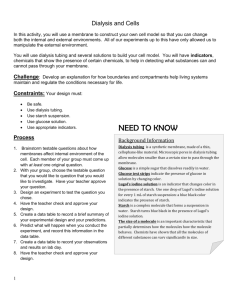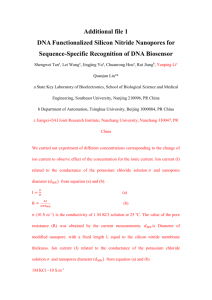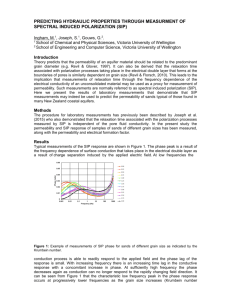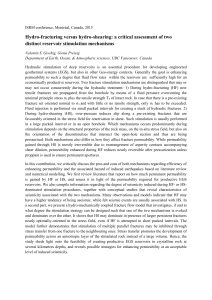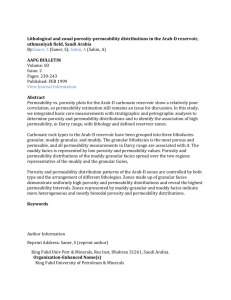Objective:
advertisement
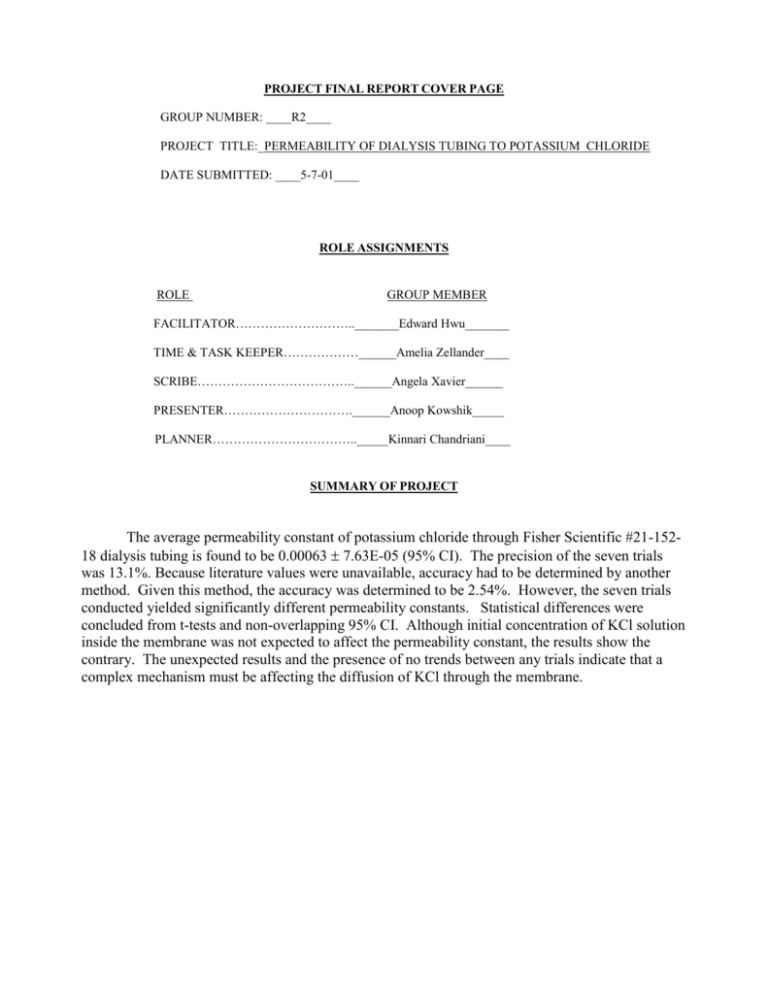
PROJECT FINAL REPORT COVER PAGE GROUP NUMBER: ____R2____ PROJECT TITLE:_PERMEABILITY OF DIALYSIS TUBING TO POTASSIUM CHLORIDE DATE SUBMITTED: ____5-7-01____ ROLE ASSIGNMENTS ROLE GROUP MEMBER FACILITATOR……………………….._______Edward Hwu_______ TIME & TASK KEEPER………………______Amelia Zellander____ SCRIBE………………………………..______Angela Xavier______ PRESENTER………………………….______Anoop Kowshik_____ PLANNER…………………………….._____Kinnari Chandriani____ SUMMARY OF PROJECT The average permeability constant of potassium chloride through Fisher Scientific #21-15218 dialysis tubing is found to be 0.00063 7.63E-05 (95% CI). The precision of the seven trials was 13.1%. Because literature values were unavailable, accuracy had to be determined by another method. Given this method, the accuracy was determined to be 2.54%. However, the seven trials conducted yielded significantly different permeability constants. Statistical differences were concluded from t-tests and non-overlapping 95% CI. Although initial concentration of KCl solution inside the membrane was not expected to affect the permeability constant, the results show the contrary. The unexpected results and the presence of no trends between any trials indicate that a complex mechanism must be affecting the diffusion of KCl through the membrane. OBJECTIVE: The objective of the experiment was to determine the permeability constant of potassium chloride through Fisher Scientific #21-152-18 dialysis tubing within a precision of 5%. An aim of this experiment was to observe the affects of varying initial concentrations (0.5 M, 1.0 M, and 3.0 M) of potassium chloride solutions on the permeability constant. Because the permeability constant describes the filtering capabilities of dialysis tubing, the value obtained would provide valuable information for use in dialysis. The permeability constant is directly related to the time needed for purification of a solution, which can be used in various laboratory and medical applications (such as purification of proteins and hemodialysis). BACKGROUND: Before interpreting the data, several information sources were used. To relate concentration to the equivalent conductance of the solution, the CRC Handbook of Chemistry1 was consulted. The handbook lists several concentrations (M) of KCl and their associated conductances (S-cm2/mol). From the provided data, a relationship between conductance and concentration of KCl was determined. To convert the measured conductance, Physical Chemistry for the Chemical and Biological Sciences2 was used. It provided the necessary equations required to calculate the equivalent conductance, which was then used to calculate the concentration of the solution. In addition, the book presented basic background of the nature of conductance and physical chemistry of solutions. The Cole-Parmer Model 19101-10 digital conductivity meter manual3 was also consulted to understand how the machine worked. It provided information regarding the cell constant used in calculations. Lastly, Robert Gagnon’s website4 provided the platform to derive equations to solve the cubic equation in converting conductance to concentration. The permeability constant of a membrane is a quantitative measure of the diffusion rate across a cell boundary. Because it greatly pertains to biological systems, there has been a great deal of research regarding membrane stretching and a consequent increase in permeability. Research on mitochondrial membranes has concluded that swelling is a major contributor to changes in the structuring of the membrane and its permeability.5 Other research in the past has also indicated that swelling of the polymer due to preparation conditions accounts for changes in the permeability constant.6 THEORY AND METHODS OF CALCULATIONS: The permeability constant (kp) is a characteristic of a membrane that is measured with respect to the flux and concentration gradient of the two solutions. Given only a conductivity meter, by using Kohlrausch’s relationship and the definition of equivalent conductance a relationship between conductance and concentration can be constructed. Kohlrausch’s Relationship Λ = Λo –B√c m (1) C kcell c (2) For a solution of KCl, the molar conductance is equal to the equivalent conductance. Using values from the CRC Handbook of Chemistry and combining the above two equations, a cubic equation in terms of concentration is derived. Because Microsoft® Excel cannot solve this equation, a formula is supplied in the appendix to help with the conversion from conductance to concentration. B c 3 2 0 c C kcell 0 (3) Where Λ = Equivalent conductance Λo = Equivalent conductance at an infinite dilution B = a constant dependent on the ion c = concentration Λm = Molar conductance C = Conductance kcell = Cell Constant By using the definition of flux and the conservation of mass formula, an equation in terms of concentration can be achieved. Flux d mass dt ci( 0) Vi kp A ci( t) co( t) (4) ci( t) Vi( t) co( t) Vo (5) Where Kp = Permeability Constant A = Surface Area ci(t) = Concentration of the inside compartment c0(t) = Concentration of the outside compartment Vo = volume in outside compartment Vi = volume in inside compartment Combining these equations together, and then reducing the equation, kp can be determined. ln Vi ci ( 0) co ( t) Vo Vi ln Vi ci ( 0) co ( t) Vo Vi A Vo Vi t ln V c ( 0) i i Vo Vi K p K p A Vi t lnVi ci ( 0) (7) (8) Using equation (8), the concentration of KCl can be calculated at any time during the experiment. MATERIALS/APPARATUS: 1. Potassium Chloride (KCl) provided by Fisher Scientific 2. DI Water 3. Cole-Parmer Model 19101-10 Digital Conductivity Meter 4. Fisher Scientific #21-152-18 Dialysis Tubing 5. Spectrum dialysis tubing clamps 6. Fishing Line and swivel apparatus 7. Fisher Scientific Mini-Pump Variable Flow 8. Magnetic stirrer, rod, and mouse pad 9. Bucket large enough to hold the dialysis tubing apparatus. A 2.0 L container was used. 10. Mettler H72 electronic balance, Mettler BD6000 electronic balance 11. 10 mL plastic pipette, P-1000 air displacement pipette 12. Suspension Apparatus: a. Ring stand b. Fishing Line PROCEDURE: Preparation of Solutions Three potassium chloride solutions (0.5 M, 1.0 M, 3.0 M) were prepared using solid Fisher Scientific KCl. The largest concern was contamination, especially from skin contact, so gloves were worn and all apparatus and materials were always rinsed with deionized water before use. Large volumes of the potassium chloride solutions were made to reduce the effects of mass transfer loss. In addition, DI water was used to rinse all the KCl from the weighing boat into the flask. 18.6375 g KCl were weighed out for the 0.5 M solution, 37.275 g KCl were weighed out for the 1.0 M solution, and 111.8445 g KCl were weighed out for the 3.0 M solution all on the Mettler H72 balance. The salt was added to a 500 mL volumetric flask and deionized water was added to the mark. The flasks were covered with Parafilm to prevent evaporation of the solution and the solution was allowed to equilibrate to room temperature. Preparation of Dialysis Tubing and Bucket The dialysis tubing was cut into approximately 12 cm pieces. The tubing lengths were soaked in DI water and stored in the refrigerator until the morning when they were to be used. For each trial, the inside of the tubing was rinsed with KCl solution of the same concentration to be used for that trial. The tubing was then clamped on one end and 10.0 mL of KCl solution was transferred in using a 10 mL plastic pipette. The tubing was then clamped on the top as close to the solution as possible with minimal loss of solution, where usually one air bubble remained. Fishing line was tied to the top clamp so that its free end could hang from the hook on the ring stand. This allows for the free rotation of the dialysis tubing suspension. The entire tubing setup, which includes the tubing filled with solution, the clamps, and the fishing line were then weighed on the Mettler H72 electronic balance. Finally, the entire setup was rinsed with DI water. The tubing setup was reweighed after the completion of the trial to check for any volume change. In addition, the volume of the KCl solution inside of the tubing at the end of the trial was measured by removing it with a 10mL plastic pipette. A 2.0 L bucket was placed on the Mettler BD6000 electronic balance and the balance was tared. 1.5 L of DI water was added by mass to the bucket. A stirrer bar was placed at the bottom of the bucket and the entire bucket was placed on the magnetic stirrer with a mouse pad separating the two, serving as insulation from heat. Before the onset of the trials, the DI water in the bucket was allowed to equilibrate to room temperature. Again, the bucket was reweighed after the trial was completed to check for volume change. Preparation of the Flow Pump, Conductivity Meter and Calibration Curve The Model 19101-10 Digital Conductivity Meter Operations Manual was consulted for determining the cell constant and calibrating the meter. The meter was always kept in “ATC ON” mode during the trials. A solution of known concentration and conductivity for the same cell constant should be used to calibrate the meter. The supplied wires were used to connect the recorder port on the back of the conductivity meter to the analog-to-digital converter on the board. The flow pump and conductivity cell were cleaned before each trial by running DI water through the tubing while the pump was on. The electrode was placed in the solution with the flow pump tubing attached to it above. The speed of the flow pump was set to 8.0 on “fast” mode. Since the CRC handbook data was used in calculations, a calibration curve was produced using our conductivity meter and solutions to make sure it correlated with that of the CRC handbook. Dilutions from the 1.0 M KCl solution as prepared above were made ranging from 0.001 M to 0.01 M in increments of 0.001 M. Dilutions of such low concentrations were prepared because the concentrations in the trials would only reach small values in this range. A P-1000 air displacement pipette and 100 mL volumetric flask were used for the 0.006 M - 0.01 M dilutions, while the same pipette and a 200 mL volumetric flask were used for the 0.001-0.005 M dilutions. RESULTS: In order to relate conductance to concentration, seven sample solutions were made to correlate concentration with conductance. The results deviated from the CRC values by 5%. Because of the small error of 5%, the relationship from the CRC values was applied. Figure 1, below, relates concentration with conductance. FIGURE 1: CALIBRATIONS CRC Handbook equiv conductance [m S*cm ^2/m ol] 155000 y = -89068x + 149749 150000 R2 = 0.9997 145000 140000 135000 130000 125000 0 0.05 0.1 0.15 0.2 0.25 0.3 0.35 root conc [M^0.5] REGRESSION STATISTICS FOR FIGURE 1 Standard Coefficients Error Intercept 149749.1 41.63883 X Variable 1 -89067.9 1032.932 t Stat P-value Lower 95% Upper 95% 3596.38 7.73E-08 149569.9 149928.2 -86.2282 0.000134 -93512.2 -84623.5 Because the values of concentrations expected during the experiment were at most 0.003 0.001M, only the CRC values below 0.005M were used. The linear regression for those points is shown above. The slope was found to deviate by 4.9% of the mean, while the y-intercept deviated by 0.1% of the mean. To calculate the kp values and observe trends, many measurements were taken before and after each trial was conducted. Table 1, below, displays the measurements that were taken for each trial. Table 1: Initial and Final Measurements. Results Trial 1 Trial 2 Trial 3 Trial 4 Trial 6 Trial 7 Trial 9 Molarity 1.0 0.5 1.0 3.0 3.0 0.5 0.5 Vout (L) Initial 1.588 1.500 1.500 1.500 1.500 1.500 1.500 Vout (L) Final 1.55 1.483 1.449 1.494 1.502 1.493 1.495 % change of volume of tank -2.39 -1.13 -3.40 -0.40 0.13 -0.47 -0.33 Vin (L) Initial 0.006 0.010 0.010 0.010 0.010 0.010 0.010 Vin (L) Final 0.0060 0.0110 0.0097 0.0107 0.0118 0.0096 0.0120 % change Tubing of volume Length in tubing Final (cm) SA (cm2) 0.00 5.9 29.5 10.00 7.4 37.0 -3.00 7.4 37.0 7.00 7.0 35.0 18.00 6.9 34.5 -4.00 7.3 36.5 20.00 8.0 40.0 Table 1 shows that there was a decrease in the outside volume over time, with an accompanied increase of internal volume over time. The average percent change for the outside volume is 1.14% and 6.86% for the inside volume. The percent change in volume also differs for each trial, showing that there were no trends, even between trials of similar concentration. Further note should be made that during the course of each trial, less than 3.2% of the total water mass was lost over time. Because the mass loss and change in volume are insignificant, calculations were done assuming that the volume did not change over time. Using equation 8, a graph was constructed where the slope was defined to be kp. Figure 2 displays the graphs of the permeability constants for all the trials. Figure 2: Graph for Permeability Constant for the 7 Trials Figure 2, above, displays the change in the permeability constant over time. The permeability constant (the slope) is linear only within the first hour. After the first hour the permeability constant gradually decreases. After 10 hours, the permeability constant for trial 3 has been reduced by a factor of 80. The chart also shows that the starting points for the trials are clustered by concentration. Table 2: Permeability Constants Permeability Constants Trial 1 Trial 2 Trial 3 Trial 4 Trial 6 Trial 7 Trial 9 Molarity 1.0 0.5 1.0 3.0 3.0 0.5 0.5 Kp 5.56E-04 7.19E-04 5.27E-04 6.86E-04 7.19E-04 6.46E-04 5.56E-04 Descriptive Statistics for Kp 95% CI 1.60E-05 3.30E-06 3.30E-06 4.40E-06 1.90E-06 1.60E-06 2.30E-06 Mean Standard Error Median Standard Deviation Sample Variance Range Minimum Maximum Confidence Level(95.0%) 0.00063 3.12E-05 0.000646 8.25E-05 6.8E-09 0.000192 0.000527 0.000719 7.63E-05 Table 2, shows the experimental permeability constants for each trial with their 95% CI. The table clearly shows that the 95% CI values do not consistently overlap one another. A precision of 13.1% was calculated for the 7 trials. Table 3: Y-intercepts Trial 1 Trial 2 Trial 3 Trial 4 Trial 6 Trial 7 Trial 9 Molarity 1.0 0.5 1.0 3.0 3.0 0.5 0.5 Y-intercept* Y-intercept (theoretical) -5.11600 -5.29832 -4.60517 -3.50656 -3.50656 -5.29832 -5.29832 (experimental) -5.2515 -5.4222 -4.7463 -3.5709 -3.5992 -5.4122 -5.4637 95%CI 0.02273 0.004798 0.004814 0.003022 0.002732 0.003049 0.004883 % error 2.65 2.34 3.06 1.83 2.64 2.15 3.12 Average 2.54 *Y-intercept = ln(Vi*Ci(0)) Table 3, above, shows the theoretical and experimental Y-intercept values of Figure 2. As can be seen, the experimental Y-intercepts do not match the theoretical Y-intercepts within the 95% CI, and are consistently smaller than the theoretical values. Table 3 also indicates an average percent error of 2.54%, indicating a high degree of accuracy. Figure 3: Normalized Data Series Figure 3 normalizes the seven trials to trial 9. Trial 9 was chosen because it was run for the shortest amount of time. The data shows that for the first 16 minutes, the seven trials are all very linear. After that time, the seven trials begin to diverge. The first to diverge are the two 1.0 M trials. To compare the data by concentrations, three t-tests were done on the different concentrations (1.0M vs. 3.0M, 0.5M vs. 1.0M, and 0.5 vs. 3.0M). Table 4: T-Tests for 1.0M and 3.0M solutions T-Test: Two-Sample Assuming Unequal Variances 1.0 M 3.0 M Mean 0.000541 0.000702 Variance 4.14E-10 5.43E-10 Observations 2 2 Hypothesized Mean Difference 0 df 2 t Stat -7.35848 P(T<=t) one-tail 0.008986 t Critical one-tail 2.919987 P(T<=t) two-tail 0.017972 t Critical two-tail 4.302656 Table 5: T-Tests Between Concentrations Comparison T-stat T-critical 0.5 M vs 1.0 M 2.004455 4.302656 0.5 M vs 3.0 M -1.24291 4.302656 1.0 M vs 3.0 M -7.35848 4.302656 Table 4, displays the results for the 1.0M and 3.0 M trials. The results indicate that the kp values for the two concentrations are significantly different. Table 5 displays the t-test results for the other concentrations. The 0.5M vs 1.0M and 0.5M vs 3.0M solutions were found not to be significantly different. ANALYSIS: The slope at a particular point in time of the graph displayed in Figure 2 was defined to be the permeability constant at that time (by equation 8). The slope has a linear region for approximately the first forty minutes, and then decreases towards zero gradually over time. Although the assumption was that the permeability constant would remain constant over time, the graph shows the permeability constant gradually decreasing to zero. The slope would be expected to be linear while there was a concentration gradient. However, this is not the case with the experimental data. After 2 hours, none of the solutions had reached equilibrium, yet the kp values had drastically changed. Table 2 lists the observed kp values with their 95% confidence limits. The mean permeability constant was calculated to be 0.00063 (cm/hr) 7.63E-05 (95% CI). However, this number should not be associated with the KCl permeability constant of the dialysis tubing because of the statistical differences in trials. The kp values obtained for each trial are displayed in Figure 2, as well as tabulated with their 95% confidence intervals, in Table 2. Comparing the values obtained for the trials with the same initial concentrations, the kp values do not overlap each other within 95% CI, indicating that they are significantly different. Also three different t-tests for unequal variances were performed on the data as indicated in Tables 4 and 5. By comparing their respective t-stat and t-critical values, the indication is that there is no significant difference between the kp values when using the initial concentrations of 0.5M and 3M, or between 0.5M and 1M. However, the kp values obtained for 3M and 1M initial concentrations are significantly different. Looking at the 0.5M solutions, it is also can be observed that the 0.5M solutions had the greatest amount of spread and therefore less internal consistency, and therefore no conclusions can be made about the 0.5M solutions. The prediction that the permeability constant would not depend on initial concentration inside the membrane and would be constant for all trials has been disproved. This information proves that there is no validity to the calculated average kp value of 0.00063 (cm/hr) 7.63E-05 (95% CI). The poor precision of 13.1% further indicates that the values deviate from each other significantly. Table 3 shows the theoretical and experimental y-intercept values of Figure 2. Since literature values were not available, an alternate method for checking the accuracy of the permeability constant was devised. Because equilibrium is reached after more than twelve hours, it was not practical to compare the final concentration of the solution to the theoretical equilibrium concentration. Therefore, the initial concentration was used to check for accuracy. The y-intercept represents the natural log of the initial number of moles placed into the membrane. Since the number of initial moles for each trial is known, this value can also be calculated and compared to the experimental y-intercept of Figure 2. The average accuracy of the y-intercepts for the trials is 2.54%. The experimental results were consistently smaller than the theoretical values, indicating that not all of the mass is accounted for in equation 8. The normalized data plot shown in Figure 3 further proves that there is a significant difference between each trial. The graphs do not follow the same pattern or linearity throughout the plot. Observance of the plot for each initial concentration indicates that the two trials for 1.0M solutions are similar in pattern and linearity. However, there is no pattern between the trials for 3.0M or 0.5M. Using the graph and Table 1, no trends between different concentrations or within the same concentration are observed, leading to no conclusion about the effects of concentration. Deviation of kp over time can be attributed to two explanations. First, the dialysis tubing could have stretched, thus changing its physical properties. As listed in Table 1, there was an average increase of 6.86% in volume of the solution in the dialysis tubing at the end of the trials. The change in volume due to swelling supports the claims made in past research. An increase in volume, straining the membrane, could result in the stretching of the shape and size of the pores. Stretching by plastic deformation occurs in polymers. (The dialysis tubing is a polymer.) The mechanism for this deformation is lining up of the polymer chains. Because the gaps in the polymer chains are the pores of the membrane through which molecules move, the lining up of these chains would alter the pore shape and size. The change in pore shape will limit the KCl passing out of the tubing. Additionally, the volume increase in the tubing increases pressure which could increase the force applied to the inside solution by the membrane. From Figure 3, the 3.0M solutions approaches equilibrium slower than the 1.0M, supporting this hypothesis. The comparison between the 0.5M and 1.0M solutions disproves this hypothesis. Furthermore, the change in volumes of the solution does not correlate with the concentrations of the solutions. In addition, clogging of the pores by the potassium chloride ions could also explain the changing kp. As the K+ and Cl- permeate through the membrane, they gradually build up a residue around the pores. As the build up increases, additional charge repulsion could hinder the passage of ions. Figure 3 indicates that the 1.0M KCl approaches equilibrium earlier than the 3.0M and 0.5M solutions. However, assuming that KCl would hinder the passage of molecules, the 3.0M solution would reach equilibrium first, which is not observed. The 0.5M KCl would approach equilibrium last which is supported by Figure 3. Since neither of the above two explanations are supported by the data, the change in kp can not be attributed to just one factor. Rather, a more complex mechanism than the ones examined are probably responsible for the change in kp over time. While unable to quantitatively determine the mechanism involved, in agreement with past research, swelling and the preparation conditions are found to contribute to the change in kp. The average uncertainty of the permeability constants was 21%. Such a high uncertainty suggests that the data from this experiment is inconsistent. This is further supported by the statistical differences in all trials. Overall, the nature of the available apparatus and methods used is insufficient for correct calculation of the permeability constant. 5% of this uncertainty is attributed to the linear regression values derived from the values in the CRC Handbook. 8% of the uncertainty was found to come from the preparation techniques involving the 10mL pipette. Furthermore, the initial setup was complicated by a constant mixing of solutions. For future reference, it is suggested to find a better method of setting up the filled dialysis tubing. In addition, measuring the volume inside the tubing after each trial was found to be incredibly difficult. To reduce error, all measurements should also have been done by weight for increased accuracy. CONCLUSIONS: 1. The data was inconsistent with expected results because the permeability constant did not remain constant over time and varies inconsistently with differing concentrations. 2. The initial permeability constant of KCl at 26oC is calculated to be between 5.3E-04 and 7.2E-04. 3. Changes in volume and mass occurred during each trial, which may be the cause of the unexpected variance in the permeability constant. REFERENCES: 1. Lide, David R. CRC Handbook of Chemistry and Physics. CRC press, Boca Raton, 80th edition, 1999. 2. Chang, Raymond. Physical Chemsitry for the Chemical and Biological Sciences. University Science Books, Sausalito, CA, 3rd edition, 2000. 3. Cole-Parmer Model 19101-10 digital conductivity meter manual. 4. Gagnon, Robert. http://www.1728.com/cubic.htm. 5. Garlid, Keith D., Beavis, Andrew D. Swelling and Contraction of the Mitochondrial Matrix. The Journal of Biological Chemistry. 260(25):13434-13441, 1985 November 5. 6. Okada J. Masuyama Y. Kondo T. An analysis of first-order release kinetics from albumin microspheres. Journal of Microencapsulation. 9(1):9-18, 1992 Jan-Mar. Appendix: Solving the cubic equation: [taken from http://www.1728.com/cubic.htm ] AUTHOR - Robert Gagnon By using the depressed cubic equation and given a cubic equation in the form ax3 + bx2 + cx + d = 0, the following formula will solve for x (which is equal to sqrt(c)) f = [3c/a –(b/a)2]/3 g = [2*(b/a)3 – 9bc/a2 + 27d/a]/27 h = [(g/2)2 + (f/3)3] if h > 0 m = [-(g/2) + sqrt(h)]1/3 n = [-(g/2) - sqrt(h)]1/3 X1 = (m + n) - (b/3a) X2 = X3 = 0 if h < 0 r = [sqrt((g/2)2-h)]1/3 θ = arcos(-g/2r) s = -r t = cos(θ/3) v = sqrt(3)*sin(θ/3) w = -b/3a X1 = 2r*cos(θ/3) + s X2 = s(t+u) + w X3 = s(t-u) + w

